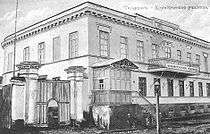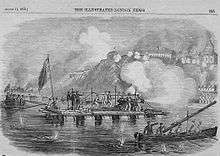Siege of Taganrog
| Siege of Taganrog | |||||||
|---|---|---|---|---|---|---|---|
| Part of the Crimean War | |||||||
 Bombardment of downtown Taganrog from a British raft during the first siege attempt. | |||||||
| |||||||
| Belligerents | |||||||
|
|
| ||||||
| Commanders and leaders | |||||||
|
|
| ||||||
| Strength | |||||||
|
1,900 men 1 steamer 2 gunboats |
16,000 men 17 steam boats 20 gunboats | ||||||
| Casualties and losses | |||||||
|
Unknown 20 commercial vessels destroyed |
Unknown 1 gunboat destroyed | ||||||
The Siege of Taganrog was a series of military actions between June and August 1855 during the Crimean War. British and French forces attempted to capture the city of Taganrog and so gain access to Rostov-on-Don, an important city for Russian military operations in the Caucasus.
Prelude
In the spring of 1855, as the Crimean War dragged on into its third year, the British and the French decided to begin operations in the Sea of Azov. They reasoned that this would allow them to cut off the Crimea even further from Russia and prevent further supplies from reaching Russian forces there by sea via the seaports in the Taman. This strategy required them to occupy the Strait of Kerch, which was to be undertaken by a joint force of British and French soldiers and warships.
Taganrog, at the far eastward end of the Sea of Azov, was selected as a potential target for attack. Taganrog is located on a strip of land jutting out slightly into the Sea of Azov and, to the British and the French, formed an excellent stepping stone to Rostov-on-Don. Taking Rostov-on-Don would allow the allies to threaten the rear of the Russian forces.
Plans were drawn up, and the British and French prepared 16,000 ground troops and about forty small warships for the "Azov Campaign". Meanwhile, Taganrog's governor-general, Nikolay Adlerberg, had been replaced by Yegor Tolstoy, an ageing but versatile general, who had served in the Russian Army in fighting against the Turks. In April 1854, Tolstoy assumed command at Taganrog, along with Ivan Krasnov (who commanded the Don Cossacks in the region) and prepared his forces. He had two regiments of Don Cossacks and a local garrison of some 630 soldiers at his command at the time of the siege. A unit of "home guards", totalling 250 men, were recruited from the local population. Taganrog lacked any modern fortifications and Tolstoy had no artillery to speak of.
Siege of Taganrog
First phase
Starting on 24 May (12 May O.S.), 1855, the British and the French began operations in the Sea of Azov. They landed troops on either side of the Kerch Strait, quickly capturing the cities of Kerch and Enikale. Following those actions, naval forces destroyed the Russian coastal battery at Kamishevaya Bay and entered the Sea of Azov.
On 2 June 1855 the Anglo-French squadron, which consisted of 17 armed steamboats and 20 gunboats commanded by Admiral Edmund Lyons and Captain Béral de Sedaiges, appeared off Taganrog after crossing the Sea of Azov. The commanders of the expedition sent the Russian forces in the city an ultimatum to surrender. The message arrived on 3 June, and was met by Tolstoy's official for important missions, Baron Yevgeny Pfeilizer-Frank (nephew to former governor Otto Pfeilizer-Frank) and poet Nikolay Sherbina, who later described the event in Moskovskiye Vedomosti on 21 June 1855. The allies demanded the surrender of all government property, all of which was to be destroyed. After an hour of consideration Baron Pfeilizer-Frank returned to the envoys with Tolstoy's reply, rejecting the demands.[4] The Anglo-French fleet began an initial bombardment of Taganrog that lasted about six and a half hours. All the stores of grain, timber, tar, all the boats in the harbour and any boats under construction, together with the Customs House and the main government buildings were ablaze.[5] A landing operation near the Old Stone Steps (Каменная лестница) and Greek Church in downtown Taganrog followed the bombardment. However, the allies were repulsed by the Cossacks and the volunteer corps. Having failed to take the city, the fleet retreated to launch other operations in the Sea of Azov.
Second phase

After the first phase of the Siege of Taganrog, the Russians deployed another fourteen regiments of Don Cossacks to the region around the Sea of Azov to protect the various coastal cities. This brought the total number of Cossack regiments in the area to 16. These new forces arrived at the time when the British and French began planning a second attempt at reaching Rostov on Don. Early in the month, the fleet of allied warships moved back through the Sea of Azov towards Taganrog, attempting to force their way up the Don River. Starting on 7 July the fleet began bombarding Taganrog again. Their attempt to move upriver on the Don was brought to a halt, however, due to the Russian steamer Taganrog and a pair of gunboats. Towards the end of July, the British-French fleet withdrew from the Taganrog region of the Sea of Azov.
Third phase
A third siege attempt was made by the British and the French beginning on 19 August. However, their indecisiveness on how to take Taganrog allowed the Russians to build up fortifications and bring in reinforcements to make the city a stronghold. The combined British-French fleet attempted to move in to the city, but were pushed back by cannon fire and ground fire and could not launch appropriate ground operations against the city.
Blocked, the fleet moved back out into the Sea, but continued to bombard Taganrog for several weeks. Early in this bombardment, the allied fleet received a minor setback after local fishermen moved various buoys that marked water depth. This had the end result of forcing HMS Jasper, a British gunship, ashore on Krivaya Spit or "Crooked Spit" near the present-day town of Sedovo in Ukraine. The ship was seized by Don Cossacks and sunk with explosives found on board.[6][7][8] Dissatisfied with the results, the allies pulled back on 31 August, retreating back out into the Sea of Azov.
Following the retreat from the Gulf of Taganrog, the British and French continued to launch minor military operations at coastal Russian positions, but these efforts simply wasted manpower. Naval operations ceased on 23 October.
Conclusion
Defence forces at Taganrog stood down on 21 June 1856, and life in the city began to return to normal. The Crimean War cost the city of Taganrog more than one million rubles. Considerable damage was done to local structures. Twenty mansions were completely destroyed, and 74 were damaged to some degree. One hundred and eighty-nine other buildings, primarily granaries and storehouses, were destroyed and 44 damaged. Tsar Alexander II exempted the citizens of Taganrog of having to pay taxes for the year of 1857.
163 Taganrog soldiers were awarded with medals and military orders because of their service during the siege.
Gallery
-

Mansion of Ioannis Varvakis that was known as the House with Bullets as the building was filled with bullets and cannonballs during the siege in 1855
-

Monument to defenders of Taganrog in 1855.
-

"LADY NANCY" raft attacking Taganrog (third siege attempt in August, 1855).
-

Russian engraving showing the first siege attempt (dated 22 May 1855).
-

Russian engraving showing the first siege attempt (dated 22 May 1855).
-

Cannonball in the wall of Saint Nicholas the Wonderworker Church.
See also
External links and references
- ↑ The Edinburgh Gazette, 29 June 1855
- ↑ The Edinburgh Gazette, 29 June 1855
- ↑ Letters from headquarters or The realities of the war in the Crimea, by Somerset John Gough-Calthorpe (7th baron.), London, 1856
- ↑ "Destruction of Russian Stores at Taganrog" in The Illustrated London News, 14 July 1855
- ↑ The attack on Taganrog June 1855,
- ↑ The New York Times, 30 August 1855
- ↑ The Moreton Bay Courier (Brisbane, Qld. : 1846 - 1861), Saturday 15 December 1855, page 2
- ↑ Mid-Victorian RN vessel HMS Jasper
- "Оборона Таганрога и его окрестностей" by Ivan Krasnov, Saint Petersburg, 1862
- "История Таганрога", П.Филевский, Moscow, 1898
- Taganrog Encyclopedia, 2nd edition, Taganrog, 2003
Оборона Приазовья в Крымской войне 1853-1856 гг.
Coordinates: 47°12′15″N 38°56′32″E / 47.20417°N 38.94222°E


